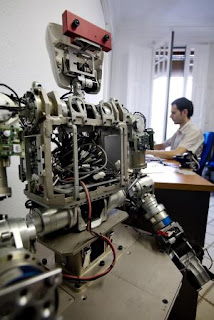
Spanish researchers have carried out a study looking into the potential future impact of robots on society. Their conclusions show that the enormous automation capacity of robots and their ability to interact with humans will cause a technological imbalance over the next 12 years between those who have them and those who do not.
International experts working on inventing and adapting cutting edge robots for practical use were interviewed during the study, in order to find out by when we will be regularly using the models they are currently designing. All agreed on 2020 as a technological inflection point, because by then robots “will be able to see, act, speak, manage natural language and have intelligence, and our relationship with them will have become more constant and commonplace”, said López Peláez. This will follow a revolution in robotics after which they will no longer be sophisticated machines, but tools to be used on a daily basis, helping us with a large number of work and social activities.
What will robots do for us?
Automation currently exists in areas such as water management or unmanned aircraft that fly and shoot missiles, but whole new areas of robot use will open up in future.
One such use will be in a medical context, as exoskeletons to help disabled people move, helping to make them less dependent on others.
Even more significant will be the insertion of robots into our bodies, such as intelligent implants in the brain, which will improve our rational thought, and nanorobots to be released into the blood to clean our arteries.
Another important role will be the replacement of people working in the areas of security, surveillance or defence. According to Professor López Peláez, it is predicted that 40% of armies will be automated with robot soldiers by 2020 “just as a car factory is today, which will result in less human deaths during violent conflicts”.
Robots will be intelligent machines to be incorporated into both domestic and industrial life: they will help us to clean our houses, will milk cows on farms, and will be programmed to work 24 hours per day in factories without resting, with a yield equivalent to three day shifts. In addition, replacing human labour with robots will prevent workers from being exposed to dangerous, stressful or unhealthy environments, thus reducing labour-related risks.
The most striking feature of this technological revolution are social robots, machines with artificial intelligence, and with which we will have emotional and even intimate interactions. “A robot might be a more effective partner and a better person than the humans we actually have in our immediate lives: just as you can see dog owners talking to their pets today, soon we will be talking to robots,” says López Peláez – to such an extent that sexual robots are currently being designed to carry out pleasurable personal interactions. These will be equipped with the required sensorial abilities, such as touch. “Since they will be used as objects, sexual robots may be able to act as a future substitute for prostitution or pornography.”
The impact of a robotized society
The study also looks at the possible repercussions of incorporating robots into society. On one hand, just as with uneven access to technologies such as the Internet, they will open up a new gulf, this time a robotic one. This will result in a cultural distinction being drawn between companies and people who can afford to buy robots to help with their activities – and those who cannot. The robotic gulf will also favour more industrialised societies, potentially widening the gap between the first and third worlds, or providing greater possibilities for success in logistics and war. On the other hand, López Peláez says that “just as many Japanese people today believe that their robots are alive, we will attribute human characteristics to robots, and we may even define robots’ rights”.
Another major concern is that if robots are to carry out so many labour tasks and replace human labour, unemployment may rise just as it did in the 19th century with the invention of textile machines. The robotics experts interviewed for this study claim that factories with high robot use will retrain workers to work in other, though possibly more poorly paid, areas. However, they also point out that the situation will balance out with the development of new services involved in the design and maintenance of the robots.
0 comments:
Post a Comment